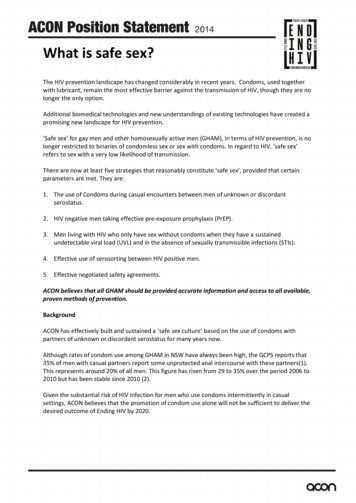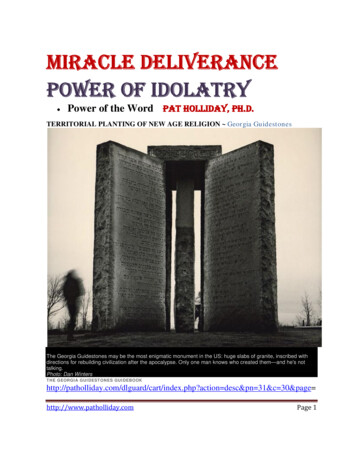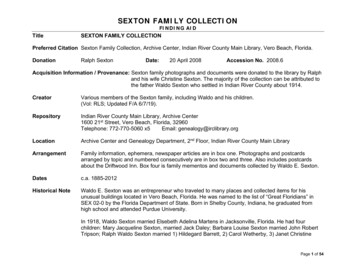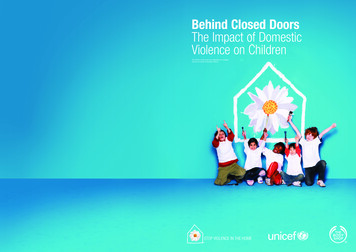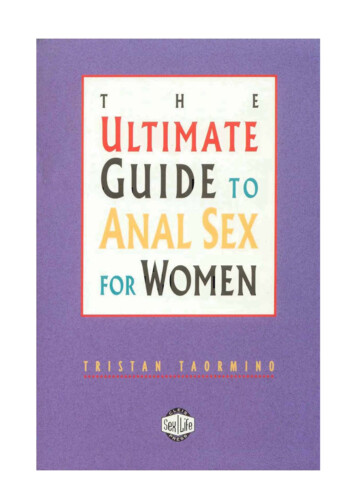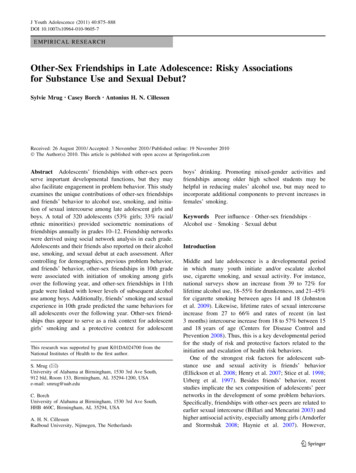
Transcription
J Youth Adolescence (2011) 40:875–888DOI 10.1007/s10964-010-9605-7EMPIRICAL RESEARCHOther-Sex Friendships in Late Adolescence: Risky Associationsfor Substance Use and Sexual Debut?Sylvie Mrug Casey Borch Antonius H. N. CillessenReceived: 26 August 2010 / Accepted: 3 November 2010 / Published online: 19 November 2010Ó The Author(s) 2010. This article is published with open access at Springerlink.comAbstract Adolescents’ friendships with other-sex peersserve important developmental functions, but they mayalso facilitate engagement in problem behavior. This studyexamines the unique contributions of other-sex friendshipsand friends’ behavior to alcohol use, smoking, and initiation of sexual intercourse among late adolescent girls andboys. A total of 320 adolescents (53% girls; 33% racial/ethnic minorities) provided sociometric nominations offriendships annually in grades 10–12. Friendship networkswere derived using social network analysis in each grade.Adolescents and their friends also reported on their alcoholuse, smoking, and sexual debut at each assessment. Aftercontrolling for demographics, previous problem behavior,and friends’ behavior, other-sex friendships in 10th gradewere associated with initiation of smoking among girlsover the following year, and other-sex friendships in 11thgrade were linked with lower levels of subsequent alcoholuse among boys. Additionally, friends’ smoking and sexualexperience in 10th grade predicted the same behaviors forall adolescents over the following year. Other-sex friendships thus appear to serve as a risk context for adolescentgirls’ smoking and a protective context for adolescentThis research was supported by grant K01DA024700 from theNational Institutes of Health to the first author.S. Mrug (&)University of Alabama at Birmingham, 1530 3rd Ave South,912 bld, Room 133, Birmingham, AL 35294-1200, USAe-mail: smrug@uab.eduC. BorchUniversity of Alabama at Birmingham, 1530 3rd Ave South,HHB 460C, Birmingham, AL 35294, USAA. H. N. CillessenRadboud University, Nijmegen, The Netherlandsboys’ drinking. Promoting mixed-gender activities andfriendships among older high school students may behelpful in reducing males’ alcohol use, but may need toincorporate additional components to prevent increases infemales’ smoking.Keywords Peer influence Other-sex friendships Alcohol use Smoking Sexual debutIntroductionMiddle and late adolescence is a developmental periodin which many youth initiate and/or escalate alcoholuse, cigarette smoking, and sexual activity. For instance,national surveys show an increase from 39 to 72% forlifetime alcohol use, 18–55% for drunkenness, and 21–45%for cigarette smoking between ages 14 and 18 (Johnstonet al. 2009). Likewise, lifetime rates of sexual intercourseincrease from 27 to 66% and rates of recent (in last3 months) intercourse increase from 18 to 57% between 15and 18 years of age (Centers for Disease Control andPrevention 2008). Thus, this is a key developmental periodfor the study of risk and protective factors related to theinitiation and escalation of health risk behaviors.One of the strongest risk factors for adolescent substance use and sexual activity is friends’ behavior(Ellickson et al. 2008; Henry et al. 2007; Stice et al. 1998;Urberg et al. 1997). Besides friends’ behavior, recentstudies implicate the sex composition of adolescents’ peernetworks in the development of some problem behaviors.Specifically, friendships with other-sex peers are related toearlier sexual intercourse (Billari and Mencarini 2003) andhigher antisocial activity, especially among girls (Arndorferand Stormshak 2008; Haynie et al. 2007). However,123
876because boys exhibit higher levels of antisocial behaviorand earlier initiation of sexual intercourse than girls(Centers for Disease Control and Prevention 2008), it is notclear whether other-sex friends exert negative influences onadolescent girls because of their gender or behavior. Toclarify the respective roles of these friends’ characteristics,this study examines the prospective contributions of sexcomposition and behavior of friendship networks to cigarette and alcohol use, as well as sexual debut among adolescent boys and girls.Other-Sex Friendships and Their Relationshipto Problem BehaviorSegregation by sex is a well-characterized feature offriendships that emerges in early childhood (LaFreniereet al. 1984) and is evident throughout the life span (Mehtaand Strough 2009) and across different cultures (Maccoby1998). Although most preadolescent friendships are withsame-sex peers, the number of other-sex friendshipsincreases throughout adolescence (Poulin and Pedersen2007). However, the features of other-sex friendships varyby gender. Adolescent girls report having more other-sexfriends than boys, and their other-sex friendships are morelikely to occur outside of school and with older peers.These gender differences emerge early in adolescence andincrease over time (Poulin and Pedersen 2007). Althoughyouth conceptualize other-sex friendships as clearly distinct from romantic relationships (Connolly et al. 1999),cross-sex friendships have long been considered animportant developmental step toward heterosexual dating(Dunphy 1963). In mixed-sex groups, adolescents learnhow to relate to the other sex, leading to lower anxiety insocial and dating heterosexual situations (LaGreca andMackey 2007) and greater subsequent engagement inromantic relationships (Connolly et al. 2000). Other-sexfriendships thus fulfill several important developmentalfunctions, such as learning to communicate with the othersex and gaining confidence in such interactions, providingemotional support, and facilitating the development ofone’s gender identity (Sippola 1999).These positive functions of other-sex friendships notwithstanding, recent literature also links such friendshipswith negative behaviors, such as earlier sexual intercourse,higher alcohol use, and antisocial activity. Specifically,college students who retrospectively reported havingopposite-sex friends in adolescence also reported earlierengagement in sexual intercourse (Billari and Mencarini2003). The findings were significant for both sexes, but theeffects were stronger for males than females. Another studyaddressing substance use (Dick et al. 2007) found thatadolescent twins with other-sex friends were 3 times morelikely to report using alcohol than those with only same-sex123J Youth Adolescence (2011) 40:875–888friends. Finally, several studies examined concurrent orprospective effects of having opposite-sex friends on adolescents’ antisocial behavior. Poulin and Pedersen (2007)reported that girls who were more antisocial in 6th gradehad more male friends in grades 6 through 10, but therewas no relationship between boys’ antisocial behavior andother-sex friendships. Similarly, Arndorfer and Stormshak(2008) found that nominating an opposite-sex peer as oneof three best friends was associated with concurrent antisocial behavior for girls, but not boys, in 6th grade.Although these concurrent associations did not emerge in7th or 8th grade, nominating an opposite-sex best friend in6th and 8th grade predicted subsequent antisocial behavior.Using the large sample of 11–19 year-old adolescents inthe Add Health study, Haynie et al. (2007) found that theproportion of other-sex friends (defined as peers who eitherreceived or gave a friendship nomination to the targetadolescent) at baseline was associated with an increasedrisk of subsequent violent behavior for girls, but decreasedrisk of violence for boys. These findings held even afteradjusting for adolescents’ previous violent behavior,friends’ self-reported violence, and demographic covariates. Additional analyses revealed that, for girls, other-sexfriendships were linked with higher violence only when thefriends reported higher levels of violent behavior. Theseresults indicated that, for girls, friendships with violentboys were associated with increased violence over time,but friendships with non-violent boys were not. For boys,friendships with girls were protective, translating intolower levels of violence regardless of the girls’ violentbehavior. However, the girls in this study reported very lowrates of violence overall, so the results may not generalizeto problem behaviors that are more common amongfemales. Altogether, this literature suggests that other-sexfriendships are associated with problem behaviors in adolescence and that these relationships may vary by sex.Alternative Explanations of Other-Sex FriendshipEffectsHowever, it is not clear whether other-sex friendshipsactually contribute to problem behavior. Many of the abovecited studies used a cross-sectional design (or a prospectivedesign without controlling for adolescents’ previous problem behavior), from which the directionality of the relationship between other-sex friendships and problembehavior cannot be determined. For instance, it is possiblethat adolescents who are more sexually experienced or whouse substances are more likely to develop other-sexfriendships, or that both problem behaviors and other-sexfriendships result from other common causes. Anothermajor limitation of much of this literature is assessing theeffects of other-sex friendships without accounting for
J Youth Adolescence (2011) 40:875–888friends’ behavior. In particular, because boys tend to havehigher rates of many problem behaviors than girls(including violence, substance use, and sexual behaviors;Centers for Disease Control and Prevention 2008), anydetrimental effects from opposite-sex friendships for girlsmay be the result of the boys’ greater problem behavior,but not their gender. Thus, a more rigorous investigation ofthe role of other-sex friendships in the development ofproblem behavior needs to include a prospective designthat controls for adolescents’ previous behavior, as well asfriends’ behavior. When both friends’ gender and behaviorare considered simultaneously, several hypotheses can begenerated about their roles in adolescents’ problembehavior. In particular, we focus on substance use andsexual debut, which are the outcome behaviors examined inthis study.Other-Sex Friendships May Lead Directly to ProblemBehaviorsThe most straightforward hypothesis is that friendshipswith other-sex peers are directly responsible for increasedsubstance use and/or initiation of sexual intercourse. Giventhe consensus in the literature that the primary functions ofmixed-sex friendship groups are to provide access topotential romantic partners and to develop interpersonalskills that would facilitate heterosexual romantic relationships (Connolly et al. 2000; Sippola 1999), it appears likelythat other-sex friendships may lead directly to dating and inturn to sexual intercourse. Indeed, mixed-sex friendshipsincrease the likelihood of heterosexual dating (Connollyet al. 2000), and dating is a strong risk factor for initiationof sexual intercourse among both adolescent males andfemales (Miller et al. 1997).Although the association may be more tenuous, othersex friendships could also lead directly to increased substance use among adolescents. If adolescents viewed theuse of alcohol and tobacco as common, desirable andappealing to the other-sex, they may initiate or escalatesubstance use to impress and be liked by other-sex friends.It is notable that adolescents typically overestimate theprevalence of substance use among their peers (Page et al.2002). Although little research has addressed substance usenorms and expectations for the other sex, a recent studywith college students showed that females overestimate theamount of alcohol males want their female friends andpartners to drink; importantly, this overestimation contributed to higher levels of drinking among these youngwomen (LaBrie et al. 2009). Similarly, perceived other-sexdrinking norms predicted college students’ alcohol usebeyond same-sex norms (Thombs et al. 2005). Anotherpotential pathway explaining increased substance useamong those with opposite-sex friends could be the use of877tobacco and alcohol to reduce anxiety associated withheterosexual interactions, such as at mixed-sex parties andgatherings. Thus, other-sex friendships may facilitate sexual debut through increased opportunities for dating, andthey may contribute to substance use through biased perceptions of other-sex norms and expectations regardingsubstance use, as well as through anxiety reductionmotives.Friends’ Behavior, but not Sex, May Lead to ProblemBehaviorA second possibility is that friends’ behavior is primarilyresponsible for problem behavior, regardless of the friends’gender. A large literature demonstrates peer influences onboth substance use and sexual behavior (e.g. Ellicksonet al. 2008; Henry et al. 2007; Stice et al. 1998; Urberget al. 1997). However, because late adolescent males aremore likely to drink alcohol, smoke, and have initiatedsexual intercourse than females (Centers for DiseaseControl and Prevention 2008), girls’ friendships with boysmay be more likely to facilitate these behaviors due toboys’ greater experience with these behaviors.One Gender May be More Susceptible to Peer InfluenceAnother possibility is that girls may be more susceptible topeer influence in general (i.e., from both same-sex andother-sex friends), which may also contribute to findings ofstronger negative peer influence from other-sex friendshipsfor girls. Girls’ greater susceptibility to peer influencecould be explained by their higher quality of friendships(e.g., intimacy, closeness, and caring; see Zarbatany et al.2000) that generally seems to amplify friends’ influence onsubstance use (Urberg et al. 2003). However, it should benoted that existing findings on sex differences in susceptibility to peer influence are mixed, with some studies notfinding sex differences (Fuemmeler et al. 2002; Urberget al. 2003) and others reporting increased susceptibility foreither girls (Dick et al. 2007) or boys (Crosnoe et al. 2002).The Behavior of Other-Sex Versus Same-Sex FriendsMay be More InfluentialIt is also possible that the behavior of other-sex friends ismore influential than the behavior of same-sex friends. Inother words, it is not the mere presence of other-sex friendsor friends’ behavior, but rather the combination of thosepeers’ behavior and opposite-sex status. Behavior of othersex friends might be more influential if these friendshipsare valued more than same-sex relationships (e.g., theyconvey higher status in the peer group), making adolescents more willing to adjust their behavior to become more123
878similar to their friends in order to maintain these importantrelationships. Consistent with this hypothesis, friends’alcohol use was more strongly associated with adolescents’own drinking for those reporting having some other-sexfriends in the Finnish twin study (Dick et al. 2007).The Behavior of Other-Sex Versus Same-Sex Friends Maybe More Influential, but Only for One GenderFor some outcomes, girls (but not boys) may be moresusceptible to the behavior of other-sex friends comparedto the behavior of same-sex friends. Girls’ greater susceptibility to other-sex friends’ behavior has been demonstrated for violence (Haynie et al. 2007). However, givenrecent evidence suggesting greater propensity of girls toalter their behavior in cross-sex friendships compared withboys (McDougall and Hymel 2007), it may extend to otherdomains as well. This greater susceptibility to other-sexbehavioral influences among girls could be explained bymultiple mechanisms, including greater desire for other-sexfriendships, better developed interpersonal skills andunderstanding of the other sex’s preferences, or greaterwillingness or ability to modify own behavior (Rose 2007).Peer Influences May Vary with DevelopmentThe influence of other-sex friendships may be furthermodified by developmental factors. Perhaps due to greatermaturity and more strongly established self-identity, selfreported resistance to peer influence increases from middleto late adolescence (Steinberg and Monahan 2007). Likewise, self-reported susceptibility to peer influence generally increases in early to middle adolescence and thendecreases in late adolescence (Berndt 1979). However,studies that examined developmental differences in theactual effects of peer behavior have not always confirmedthese self-report trends. For instance, one study found nodifferences in peer influences on adolescent smokingbetween 6th and 11th grade (Chassin et al. 1986). Inanother investigation, the proportion of friends whosmoked had a stronger effect on adolescents’ smoking in11th than in 8th grade, suggesting a stronger, not weakereffect of peer behavior in later adolescence (Urberg et al.1991). Thus, although some literature suggests that samesex and other-sex friends and friendships may becomemore influential as adolescents progress through the highschool years, other developmental trends may also occur.In summary, existing literature suggests that other-sexfriendships may increase adolescents’ problem behavior,but the relative roles of friends’ behavior, friends’ gender,and adolescents’ own gender have not been clarified. Giventhe scarcity of controlled longitudinal studies, the directionality of the associations is also unclear. Finally, many123J Youth Adolescence (2011) 40:875–888studies relied on adolescents’ self-reports of all variables(own behavior, friends’ behavior, and friends’ sex) with thepossibility that some results are caused or inflated byshared method variance. Therefore, in order to determinewhether other-sex friendships truly contribute to adolescents’ problem behavior, it is essential to utilize a longitudinal design with multi-informant data, and to account inanalyses for previous levels of problem behavior, as well asdirect and interactive effects of friends’ gender, friends’behavior, and adolescents’ gender.Goals of the Present StudyThis investigation examines the effects of other-sexfriendships on adolescents’ alcohol and tobacco use andsexual debut in late adolescence. Consistent with existingliterature on adolescent peer relationships, we conceptualize friendship influence as present within friendship groupsor cliques, defined as cohesive groups of youth who regularly interact with each other (Urberg et al. 1995). Toaddress limitations common in prior research, the currentstudy utilizes multiple informants and a prospective design,and evaluates the unique and interactive contributions ofthe sex composition of the friendship group, friends’behavior, and adolescents’ own sex on changes in substance use and sexual debut over two one-year periods,from 10th to 11th grade and from 11th to 12th grade. Basedon the literature reviewed above, we hypothesize thatboth friends’ behavior and opposite-sex friendships willuniquely contribute to the initiation of sexual intercourse,that friends’ behavior will be a strong predictor of adolescents’ alcohol and tobacco use, that the effects of peerbehavior on both substance use and sexual debut will bemagnified by the presence of other-sex friends, and thatpeer influence effects may be stronger when predictingfrom 10th grade to 11th grade than from 11th to 12th grade.MethodsParticipants and ProceduresParticipants were 320 adolescents enrolled in a larger studyof social and academic development of youth. The sampleincluded 171 (53%) girls; 67% Caucasians, 19% AfricanAmericans, 12% Hispanics, and 2% students of other ethnic origin. The study was conducted in a public schooldistrict in a mid-sized town in the Northeast of the U.S. Thepresent report includes data collected in three successiveyears (2002–2004) from a cohort of adolescents attendingthe same grade in one high school as they progressed from10th to 12th grade (approximate ages 16–18). The numbers
J Youth Adolescence (2011) 40:875–888of participating students were 363, 368, and 307 out of 543,528, and 479 students officially listed in grades 10, 11, and12, respectively. Participation rates thus ranged from 64 to67% across the 3 years. However, because the analysesused listwise deletion of cases with missing data, participants who did not have complete data for all variables usedin a given analysis were excluded from that analysis. Thenumber of cases used in individual analyses thus rangedfrom 120 to 228. A total of 320 adolescents were used inone or more analyses.Main reasons for attrition were not being officially listedon the class roster in two consecutive years (e.g., due tomoving to another school or dropping out; 11% from grade10 to 11, 21% from grade 11 to 12); not participating intwo consecutive years due to absences, recent move ordrop-out, or refusal (20 and 27%); not providing information about own substance use or sexual behavior (0–2%);not being a member of a friendship group (6% in grade 10;36% in grade 11); and missing information on friends’behavior (4%). The analytic sample (N 320) did notdiffer from excluded cases in gender composition butcomprised fewer racial/ethnic minorities. Each data collection was conducted in the spring to ensure sufficientfamiliarity of students with one another in order to yieldvalid and reliable sociometric data. Adolescents completedgroup-administered peer nomination and self-report formsin their classrooms. Identical measures were used at eachdata collection wave.MeasuresAlcohol UseAdolescents’ alcohol use was measured with two selfreport items indicating the frequency of alcohol use (‘‘atleast one drink of alcohol’’) and binge drinking (‘‘5 or moredrinks of alcohol in a row’’) in the last 30 days. Both itemswere rated on 7-point scales ranging from ‘0’ to ‘30 days’for drinking and ‘0’ to ‘20 or more days’ for bingedrinking. The two items were averaged within each grade.Combining the frequency of use with the frequency ofbinge drinking is a commonly used measure of adolescentsubstance use (e.g., Wills et al. 1998). Using the averagewas supported by strong correlations between the two items(r’s .74–.81, p \ .001, across grades 10–12), and theirnearly identical standard deviations within each wave.879Sexual DebutOne dichotomous item assessed adolescent self-report ofever having sexual intercourse.Proportion of Other-Sex FriendsAs a part of the sociometric nominations, adolescents wereasked to nominate their best friends within the entire grade.Students could nominate as many best friends as they liked;both same-sex and other-sex nominations were allowed.Friendship groups were derived using UCINET 6 (Borgattiet al. 2002) and the block modeling techniques therein. Thefriendship groups were defined as groups of two or morestudents connected by one or more reciprocal friendshipnominations. Dyads are groups in which both studentsnominated each other as friends. Groups of three include adyad in which at least one person is reciprocally connectedto another person. Groups of four are dyads where bothpeople are reciprocally connected to other students, whomay or may not be connected to others in the group. So,each friendship group has at least one dyad and all otherconnections must adhere to the principle of transitivity.Transitivity refers to the probability that if two people arefriends and one of them is friends with a third person, thenit is likely that the third person is a part of the largerfriendship group. Thus, no student is more than one reciprocal tie from any other student in the friendship group.This method has been used successfully in previous peerrelations studies (e.g., Espelage et al. 2003). Friendshipgroups ranged in size from 2 to 9–11 peers across the threegrades. For each adolescent, we then computed the proportion of his or her friends who were of opposite-sex.Friends’ Alcohol UseUsing the friendship groups described above, we computedthe average of the friends’ self-reported alcohol use scoresdescribed above under ‘‘Alcohol use’’.Friends’ SmokingFriends’ smoking was computed as the proportion offriends who reported ever smoking, using each friend’sself-report of lifetime smoking described above under‘‘Smoking’’.SmokingFriends’ Sexual InitiationAdolescents’ smoking was assessed with one dichotomousitem asking adolescents whether they ever tried cigarettesmoking.Friends’ sexual initiation was computed as the proportionof friends who reported ever having sexual intercourseusing one item described above under ‘‘Sexual debut’’.123
880J Youth Adolescence (2011) 40:875–888ResultsDescriptive statistics for adolescents and their friendshipgroups are reported in Table 1; because of hypothesizedsex differences, all descriptives are presented separately formales and females. As expected, adolescents’ averagelevels of alcohol use and lifetime prevalence of cigarettesmoking and sexual debut generally increased from 10th to12th grade, with the exception of somewhat lower rate ofcigarette smoking in Grade 11 than in Grade 10. Averageclique sizes generally decreased across the 3 years, whilethe proportion of other-sex clique members increased from10th to 11th grade and then decreased in 12th grade. Incontrast to individual substance use, clique members’average alcohol use and smoking were the highest inGrade 10.Correlations among all variables are listed in Table 2.The temporal stability of most constructs was low, suggesting substantial developmental changes in individualbehavior and the composition of friendship groups over thethree-year period. Cross-sectional correlations indicatedgenerally positive significant relationships among the threeproblem behaviors (alcohol use, smoking, sexual debut) atboth the individual and friendship group levels. Interestingly, individual problem behavior was significantly related to friends’ problem behavior primarily in Grade 10; inthe later grades, only individual and friends’ alcohol usewere significantly correlated at Grade 11.The main research questions were addressed with multiple regressions for alcohol use and logistic regressions forthe dichotomously coded smoking and sexual debut. Grade11 outcomes were modeled as a function of variablesassessed in Grade 10; Grade 11 variables predicted outcomes in Grade 12. All analyses controlled for racial/ethnicminority status and the level or presence of the sameproblem behavior in the previous year. Because continuityin behavior was modeled, the analyses evaluated the effectsof other predictors on changes in the target behavior overthe 1 year period. The main predictors of interest includedthe proportion of other-sex friends, friends’ problembehavior, sex of the adolescent, and all their interactions.The main effects tested whether having other-sex friends,friends’ problem behavior, or being male versus femalecontributed to alcohol use, smoking initiation, or sexualdebut over the following year. The 2-way interactions ofother-sex friends and friends’ problem behavior evaluatedthe hypothesis that friends’ behavior is more influential inthe context of mixed-sex friendship groups than in samesex groups. The 2-way interactions between other-sexfriends and gender tested whether having opposite-sexfriends predicts problem behavior differently for males andfemales. The 2-way interactions between gender andfriends’ behavior evaluated the hypothesis that one genderis more susceptible to the influence of friends’ behavior(regardless of the friends’ sex) than the other. Finally, the3-way interaction tested the most complex possibility thatthe behavior of other-sex friends is more influential thanbehavior of same-sex friends, but only (or more so) for onegender. All predictors were centered prior to computing theinteraction terms to reduce problems with collinearity, andsignificant interactions were followed by simple slopeanalyses (Aiken and West 1991).The results are shown in Table 3 for alcohol and Table 4for smoking and initiation of sexual intercourse. Alcoholuse in Grade 11 was marginally predicted by an interactionbetween other-sex friends and friends’ alcohol use; thepositive coefficient suggests that friends’ alcohol use maymore strongly predict higher levels of individual drinkingin mixed-sex friendship groups than in same-sex cliques. Adifferent interaction, between other-sex friends and adolescents’ sex, emerged in predicting alcohol use in Grade12. Follow-up simple slopes analyses revealed that theTable 1 Descriptive statistics for individuals by gradeGrade 10MalesAlcohol usea, M (SD).60 (1.13)Grade 11Females.47 (.93)Males.60 (1.07)Grade 12FemalesMales.61 (1.01).75 (1.16)Females.71 (1.16)Ever smoked (%)4547434350Ever had sex (%)263251505354Member of a mixed-sex cliqueb (%)313076654036Clique size, M (SD)3.8 (1.6)bProportion of other-sex friends , M (SD)4.1 (1.7)3.7 (1.8)3.3 (1.6)3.4 (1.7)483.3 (1.6).16 (.29).12 (.21).59 (.41).48 (.42).20 (.29).16 (.24)1.40 (.94)1.21 (.96).71 (.82).57 (.81)1.15 (1.25).97 (1.07)Friends’ smoking, M (SD).53 (.37).51 (.37).49 (.38).46 (.40).40 (.35).48 (.39)Friends ever had sex, M (SD).28 (.35).30 (.37).37 (.33).38 (.39).56 (.35).44 (.39)Friends’ alcohol use, M (SD)aPossible range 0 ‘‘no use’’ to 6 ‘‘drank everyday/binge drank 20 or more days’’ in the last 30 days;members of a clique123bOut of all students who were
1.02.15-.07.28*.18*.15*-.07.08.18*.27*-.12*.26*.03 -.08.09.10.03.08.10 -.03-.13*.39*-.07 5.16*.22*-.03.18*6.* p \ .05 or lower. 10–12 Grades 10–12. N ranges from 126 to 2791. Female2. Minority3. Alcohol 104. Alcohol 115. Alcohol 126. Smoking 107. Smoking 118. Smoking 129. Had sex 1010. Had sex 1111. Had sex 1212. Other-sex friends 1013. Other-sex friends 1114. Other-sex friends 1215. Friends’ alcohol 1016. Friends’ alcohol
Received: 26 August 2010/Accepted: 3 November 2010/Published online: 19 November 2010 The Author(s) 2010. This article is published with open access at Springerlink.com Abstract Adolescents' friendships with other-sex peers serve important developmental functions, but they may also facilitate engagement in problem behavior. This study
